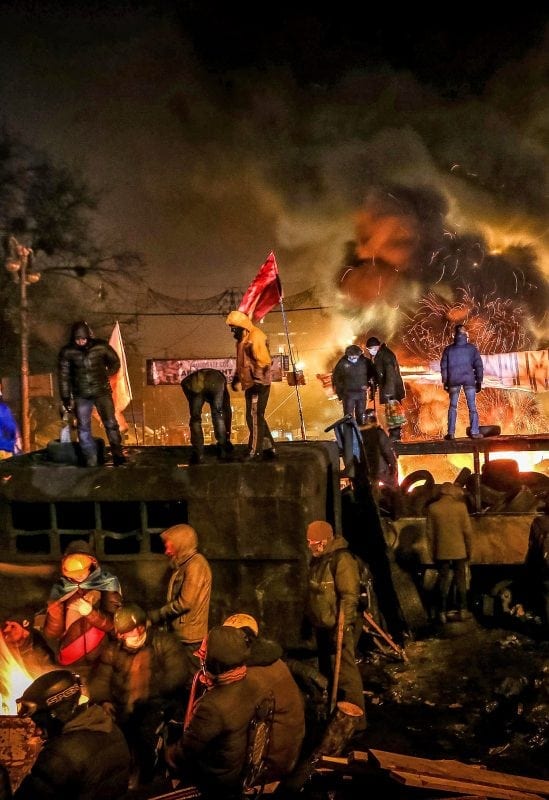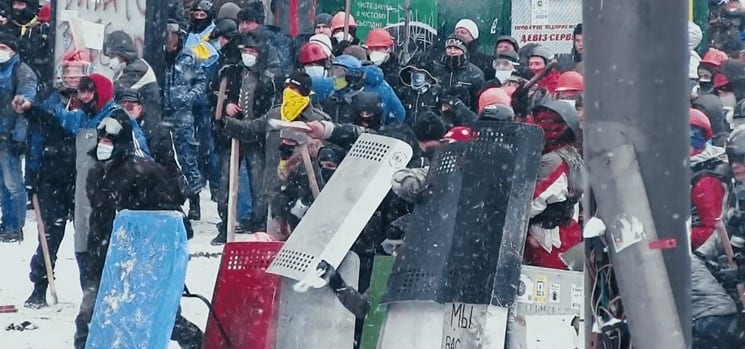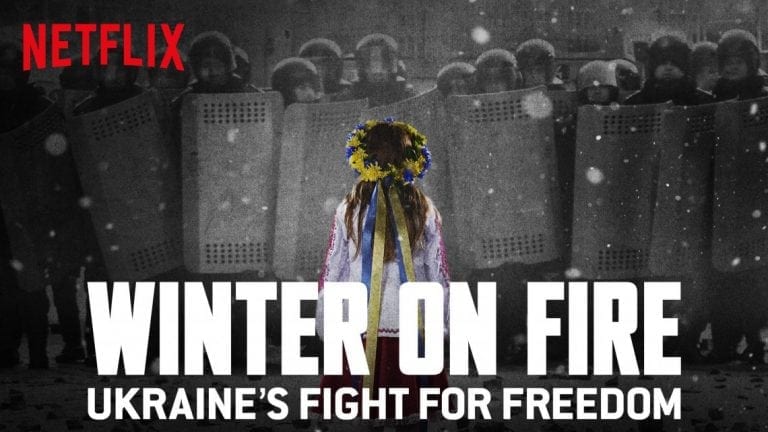
Anti-government protests in Kiev, Ukraine, in January 2014, as seen as in this documentary by Evgeny Afineevsky. Credit Arturas Morozovas/Netflix Original (NYTimes caption)
‘Winter on Fire’ tracks the 93 days Ukraine fought for its identity
‘Winter on Fire’
Filmmaker Evgeny Afineevsky flew to Kiev, Ukraine, to capture the revolution on film. The result is the documentary “Winter on Fire.” (Arturas Morozovas / Netflix Inc.)
Jeffrey Fleishman Jeffrey FleishmanContact Reporter
Evgeny Afineevsky’s “Winter on Fire: Ukraine’s Fight for Freedom” is a documentary from the front lines, a visceral portrait of a nation’s battle for its identity. The film tracks the 93 days — between November 2013 and February 2014 — when tens of thousands of protesters rallied in frigid Independence Square against gunfire, arrests and beatings to bring down President Viktor Yanukovych and upset a dangerous regional order.
With the immediacy of a news bulletin and the intimacy of a novel, “Winter on Fire,” which opens theatrically and on Netflix on Oct. 9, lacks important historical nuance even as it traces protesters struggling to free their country from Russian manipulation more than two decades after the fall of the Soviet Union. Public outrage erupted when Yanukovych, who would eventually flee the capital in darkness, edged closer to Russian President Vladimir Putin and backed away from a popular plan to strengthen ties with the European Union.
Stirrings of revolt gathered into huge anti-government demonstrations that startled the world. The uprising drew from across Ukrainian society: students, mothers, welders, priests, teachers and retired soldiers. Their stories moved at a brisk pace as crosses, coffins and placards were carried through the snow. Molotov cocktails streaked the night amid the baroque architecture of downtown Kiev.
“A friend called and said, ‘You need to come down here, history is being made,'” said Afineevsky, who packed a camera and flew to Kiev from his home in Los Angeles. “It was young people wanting their voices heard. Then it started to unfold, the police beatings…. It was so strange and so horrible.”
The director, who was born in Russia, camped in Independence Square, also known as the Maidan, with the protesters and enlisted 28 volunteer cameramen. A few of the photographers were wounded as the momentum shifted back and forth from the police to demonstrators, whose ranks were supported by religious leaders. Demonstrators wore pots as helmets, stormed police lines and retreated to a makeshift hospital at a monastery.
“What happened on the Maidan was an amazing and important chapter in Ukraine’s history,” said Afineevsky, who has made a number of documentaries, plus the romantic comedy feature “Oy Vey! My Son Is Gay.” “As a filmmaker, you want to tell the story to the world, but to me, it became a tribute to the people who stood against corruption. The people are the power.”
That is a narrow slice of a larger picture. The film does not explore the political and cultural complexities of Ukraine, which won its independence from the Soviet Union in 1991. An array of deep-seated story lines, including the ambitions of ultra-nationalists and a swath of eastern Ukraine that supported becoming part of Russia, would play out after the revolution when Putin’s forces annexed Crimea and backed separatists against the new government in Kiev.
Variety film critic Jay Weissberg writes that “Winter on Fire” amasses an “impressive amount of video footage but is hamstrung by its rose-tinted ‘the people united will never be defeated'” point of view. The Hollywood Reporter says that the film has “undeniable power” but that it does “grow repetitive because it provides so little historical context or a larger overview of how the growing authoritarianism of Putin’s Russia is affecting this part of the world.”
Evocatively photographed and woven with memorable images, such as a pianist playing in the chill near the barricades, “Winter on Fire” is reminiscent of “The Square,” the Academy Award-nominated documentary about the Egyptian uprising that toppled President Hosni Mubarak. Both films sweep the viewer into the vortex of dissent and illuminate what Afineevsky calls “the patriotic coming together of a people.”
The film reinforces the power of social media and today’s technology to document swift, world-shaping events into collage-like productions that lie somewhere between reality television and high art. Whether in the alleys of Cairo, the bombed souks of Syria or the broken streets of Kiev, the cruelties and virtues that collide in searing national narratives are increasingly accessible at a time when we view the world through the prism of an iPhone.
“Winter on Fire” is ingrained with the tenacity and sardonic humor of voices that are intimate with despair and political betrayal. One protester says of the venom aimed at Yanukovych: “Can you imagine infuriating people to such despair that a banker and one of the most influential attorneys from Lviv came to Hrushevskogo Street to throw stones at police?”
By the time Yanukovych fled Kiev — more than three months after the rallies began — at least 125 people had been killed, 65 were missing and 1,890 had been injured. An overworked doctor said of the fallen: “You close someone’s eyes and you go to another.”
“I met so many fascinating characters,” said the director. “It was all part of this uplifting human spirit…. It’s a moral story for a younger generation. They can change their future.”
One of the young protesters, Dmytro Holubnychhy, 16, crouched in an old helmet and a blue jacket at the front lines, where a man lay in the street amid scattered rocks, snow and barbed wire. “I was just dragging a dead body,” he says, the camera as close as a mirror to his face. “I stepped in blood. You thought it would be easy … not me.”
Snipers take positions. Tin and wooden shields are raised. Someone hands Holubnychhy a phone. “Mom,” he says, “I want to tell you something … I love you.”
Winter on Fire’: The View From the Trenches of a Political Uprising
Winter on Fire: Ukraine’s Fight for Freedom
By A. O. SCOTT
OCT. 8, 2015
“Winter on Fire” captures the idealism and bravery of the Ukrainians who gathered in Maidan Square to protest Mr. Yanukovych’s turn away from the European Union and toward a closer relationship with Russia. The film starts with a short, punchy history lesson, and is sprinkled with animated maps that give a street-by-street, building-by-building overview of the clashes between the protesters and various government forces. But most of what you see and hear consists of ground-level, in-the-moment acts of witness. The cameras are at the side of the demonstrators and in the path of phalanxes of riot police. Modern technology may not yet be able to capture the smell of gunpowder and tear gas, but Mr. Afineevsky takes the viewer closer to the action than might have seemed possible.
Rarely has a documentary achieved such immediacy. The clearest precedent is “The Square,” Jehane Noujaim’s 2013 record of the Egyptian upheavals that began in 2011. Ms. Noujaim’s film was attuned to the complexities of the three-way struggle for power involving the Muslim Brotherhood, the Egyptian Army and the secular democrats caught in the middle. “Winter on Fire” is a more viscerally partisan film, a work of passionate advocacy rather than political analysis. Its intention is partly to fortify Ukraine’s resistance to Russian domination, military and otherwise, and to tell a vivid tale of heroism and villainy.
Mr. Afineevsky succeeds brilliantly, turning an after-the-fact reminder of events that have faded from the headlines into a grippingly suspenseful real-life action film. What “Winter on Fire” lacks in journalistic detachment it more than makes up for in fidelity to the feelings and motives of the participants. It’s more than just a portrait of terror, anger, desperation and resolve; it communicates those emotions directly, into the bloodstream and nervous system of the audience.
There are limitations to this approach to documentary, just as there are limitations to the style of political activism it depicts. The mass uprisings of recent years have yielded ambiguous — and sometimes disastrous — results, and the transition from crowds and slogans to policies and procedures is mined with compromise and disappointment. Viewers seeking a nuanced, contextual understanding of recent events in Ukraine may not find that in “Winter on Fire.” But they will gain a powerful sense of what the Maidan revolution meant to its participants, and why they risked their lives to bring it about.
As usual, the unkindest cut (and the most treacherous) is dealt by a faux-left publication, The Village Voice, whose critic, Alan Scherstuhl, exceeds the venom distributed by his more august colleagues. See below.
BRACING DOC ‘WINTER ON FIRE’ PUTS YOU IN THE HEART OF UKRAINE’S MAIDAN PROTESTS
 BY ALAN SCHERSTUHL, The Village Voice
BY ALAN SCHERSTUHL, The Village Voice
TUESDAY, OCTOBER 6, 2015 | 5 MONTHS AGO
Bracing Doc ‘Winter on Fire’ Puts You in the Heart of Ukraine’s Maidan Protests
This time it was months of protests in the capital that sent him packing, but only after his Berkut security forces assaulted the citizenry with stun grenades, tear gas, and rubber bullets, ultimately killing 125 people. The uprising of thousands at first targeted Yanukovych for his refusal to follow through on plans to bring Ukraine closer to the European Union, but the crackdown of his troops inspired such outrage that the crowds swelled. As one man explains to one of director Evgeny Afineevsky’s cameras, “At this point it’s not even about European integration anymore — people just want to live in freedom.”
Afineevsky and his crew nose their cameras alarmingly close to the action as the truncheons swing but also as the people fight back, lobbing rocks or pressing into the authorities from behind improvised riot shields. Most of the footage here is of life in Maidan Square during this hardest of winters. Afineevsky takes us into makeshift hospitals, shows us protesters shouting “Come to the side of your nation!” at soldiers in riot gear, and offers several hard-to-shake images: protesters building barricades; the bell-ringer at a monastery ringing every bell in alarm for what he says is the first time since 1240; a man whose face is streaked with gore standing straight, still, and silent against a tree.
Looming over all of this moving, visceral footage are the tragedies to come after Yanukovych is gone and Putin feels he’s got something to prove. Winter on Fire’s thrilling rebellion is neither the beginning nor the end, but it is at least a truly heartening middle.
Winter on Fire
Directed by Evgeny Afineevsky
Netflix
Opens October 9, IFC Center
Note to Commenters
Due to severe hacking attacks in the recent past that brought our site down for up to 11 days with considerable loss of circulation, we exercise extreme caution in the comments we publish, as the comment box has been one of the main arteries to inject malicious code. Because of that comments may not appear immediately, but rest assured that if you are a legitimate commenter your opinion will be published within 24 hours. If your comment fails to appear, and you wish to reach us directly, send us a mail at: editor@greanvillepost.com
We apologize for this inconvenience.
=SUBSCRIBE TODAY! NOTHING TO LOSE, EVERYTHING TO GAIN.=
free • safe • invaluable
Nauseated by the
vile corporate media?
Had enough of their lies, escapism,
omissions and relentless manipulation?
Send a donation to
The Greanville Post–or
But be sure to support YOUR media.
If you don’t, who will?





